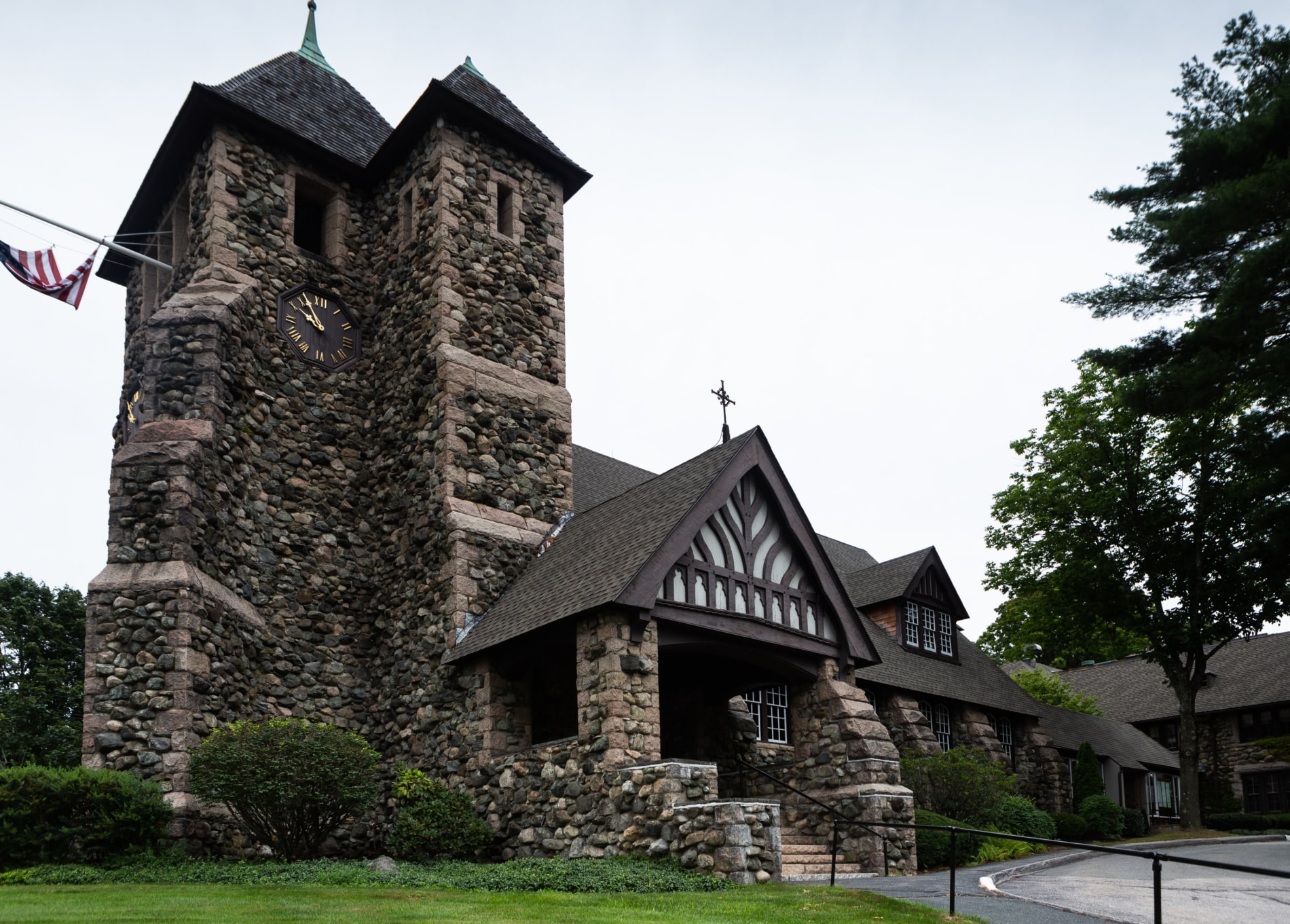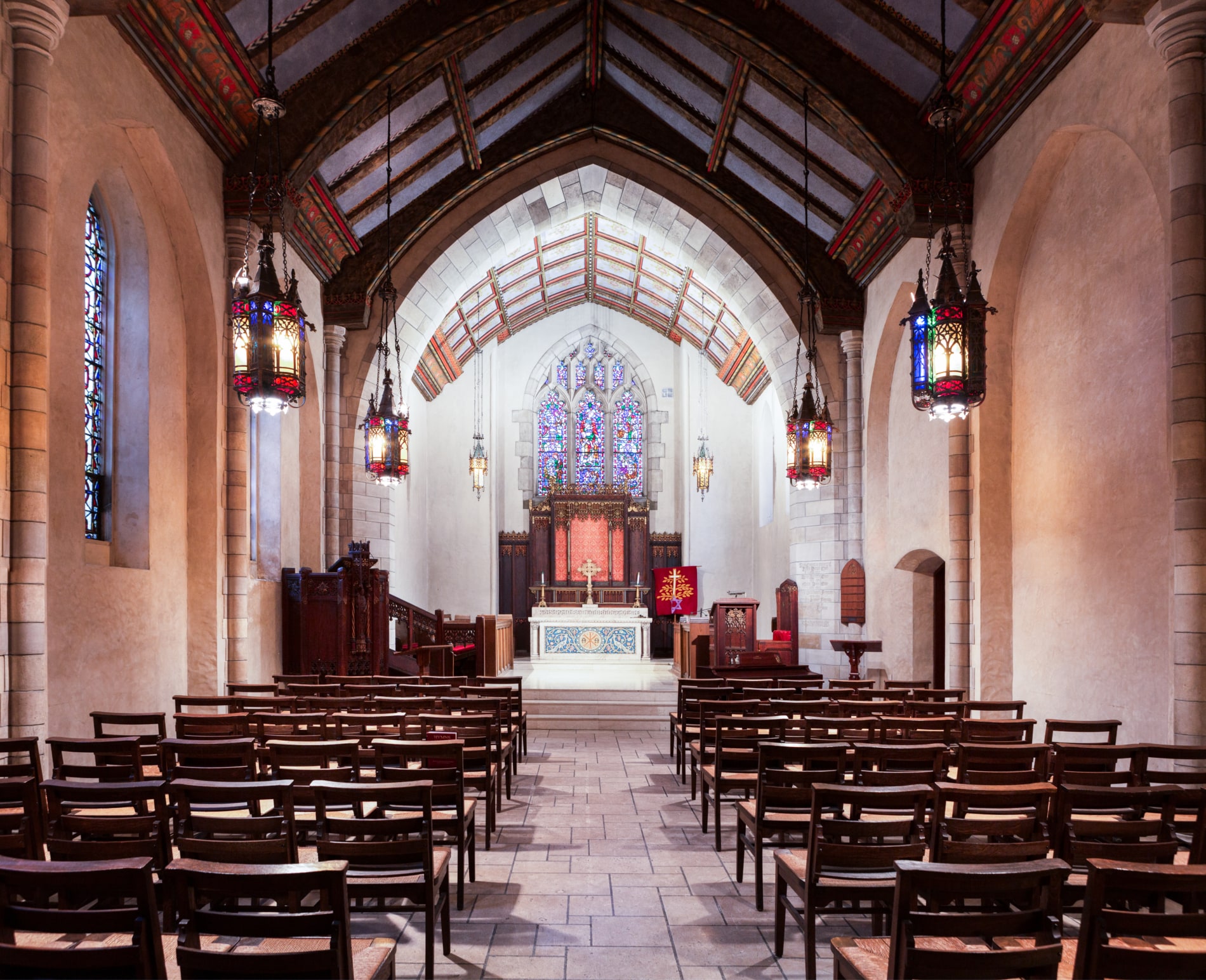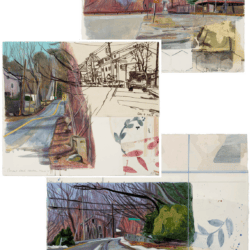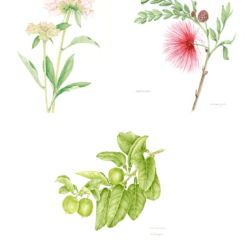Welcome to the First Parish Self-Guided Tour!
This page has been optimized for viewing on both a desktop browser and a smartphone; click or tap on the station title to open that section of the tour.
Click or tap the button below for a map with the locations of the different stations.
Station #1 — Foyer
.
Our tour starts even before you step through the doors! The foyer is made of stones of what was the original exterior of the church were brought from farmers’ fields as far as Nahant on flat wagons pulled by two or three teams of horses. The architects of this church were Peabody and Stearns. Their design may have been influenced by sketches of an English country church near Oxford England which were made by Horace Sears, son of our 6th minister.
Station #2 — Sanctuary
.
The current church building was built in 1888, and the old oak door through which you pass is one of the original exterior doors. The church was founded in 1698, when the farmers of the most westerly precinct to Watertown (the area now called Weston) were tired of making the 10 mile journey into the center of Watertown every Sunday to worship. They petitioned the General Court successfully for the right to build their own meetinghouse and to call their own minister. The first meeting house was small, only 30 by 30 feet square, and not too many feet from the current location of the sanctuary. It was finished in 1700, and in 1701 the Reverend Joseph Moore was our first called minister. The town of Weston was officially incorporated in 1713, but there was still no distinction between the town and the parish. This was the parish church and the town church; through 1824, all town taxpayers paid for the church’s upkeep and the minister’s salary (needless to say, this is no longer the case!). Over the years, new larger buildings were built to accommodate the growing congregation. The one in which you are now standing is the fourth church building.
Next, we invite you to look up at the lovely Tiffany window at the back of the sanctuary. Mrs. Henry Gowing gave it in 1899 in memory of her husband. There are three main panels to this Tiffany window — the left panel shows a woman with an ointment box on the ground and the center one an Angel sitting on a tomb. This is the resurrection scene from the gospel of Saint Luke. In the top of the window are the first and last letters of the Greek alphabet, Alpha on the left and Omega on the right signifying that God is the beginning and the end. Tiffany developed a special technique to make his windows appear multidimensional which enhanced the light.
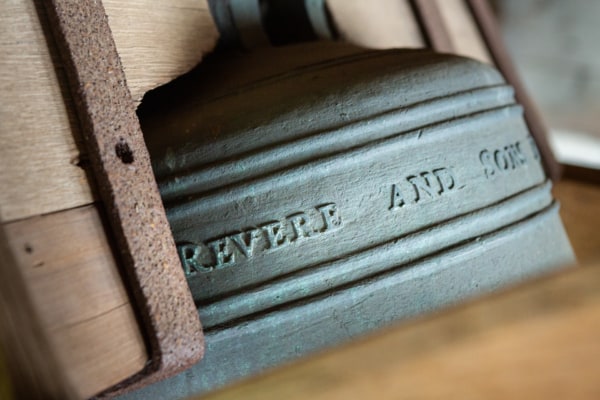
In the rear of the sanctuary (directly down the aisle from the front entrance) is the door to our bell tower. Our bell is one of the oldest Paul Revere bells still in use in New England. It rings each hour to announce the time to the whole town, and we also ring it manually for special occasions such as weddings and the September 11th memorial. At least once a year we open the tower for parishioners and visitors who want to take the winding staircase (all 65 stairs!) to the top. The town of Weston bought the bell in 1801 for $370 in cash plus trading in our old bell, which Revere would melt down to make another bell.
In the sanctuary we frequently hang banners made in the 1980’s by a devoted church quilting group led by two talented artists. On the back wall of the sanctuary, the banner has the Alpha and Omega at the bottom repeated from the Tiffany window and a fish. One of the earliest Christian symbols, the Greek word for fish is ichthys; it’s letters are the initials for “Jesus Christ, son of God, savior.”
The Choir loft was an addition to the church (creating a space called the transept) which Horace Sears gave in 1918 to provide much-needed space. Behind the choir seating, there are thousands of organ pipes. The front gilded pipes are only for decoration but above and below them you can see some of the operating pipes. It is a Hook and Hastings organ that Anna Hastings gave in 1918 in memory of her husband Francis, a member of this church. The Hook and Hastings organ factory was located here in Weston at the railroad crossing on Vile Street until it went out of business during the depression of the 1930s. Hook and Hastings built some well-known organs, including those in Riverside Church and Radio City Music Hall in Manhattan, and at the Hammond Castle Museum in Gloucester.
When facing the front of the sanctuary, the pulpit is the larger podium on the right. Its carvings honor the composer and minister, Edmund Hamilton Sears; inside of the pulpit you may read “given in memory of Edmund Hamilton Sears, by a few out of the many who love his hymns”. The lectern is the smaller podium to the left, and the table at the back is known as the altar or chancel.
The stained glass window above the altar was installed in the 1950’s, replacing a much smaller one. This window was purchased from an Episcopal Church in Manchester, Massachusetts that was being torn down. The four panels depict archangels: from the left, Michael, Gabriel, Uriel, and Raphael. The other three panels show Saints of the 13th century. The last panel is Saint Francis of Assisi and contains this line: “who gave himself for us that all should provide largely even for the animals and birds.” He is pictured with the wolf that ravaged a village during a famine. Known as the Wolf of Gubbio, in stories he persuaded the village to feed the wolf so that it would stop grabbing the children.
As you head back to main entrance, note over the table the piece of intricate embroidery from our sister church in Torda, Romania in Transylvania. The Transylvanian Unitarian church came out of the left wing of the Protestant Reformation in the 1500s and we remain connected to those communities today.
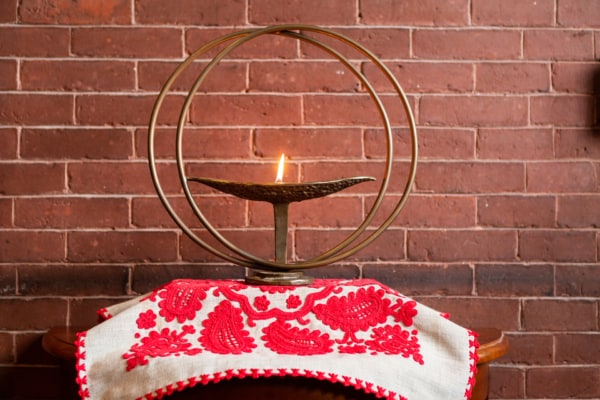 On the table by the entrance is the chalice we light every Sunday, which is a symbol of the Unitarian Universalist faith. This particular chalice was made by Unitarian Universalist Mordecai Roth. After making his career as a dentist, Roth took up sculpting in his retirement and made his first chalice on comission from a member of his home church who wanted to honor her daughter. There are a limited number of these beautiful bronze sculptures and we are honored to have one at First Parish.
On the table by the entrance is the chalice we light every Sunday, which is a symbol of the Unitarian Universalist faith. This particular chalice was made by Unitarian Universalist Mordecai Roth. After making his career as a dentist, Roth took up sculpting in his retirement and made his first chalice on comission from a member of his home church who wanted to honor her daughter. There are a limited number of these beautiful bronze sculptures and we are honored to have one at First Parish.
The flaming chalice (a candle or flame within a ceremonial cup or vessel, typically with a stem & foot) was originally designed by Austrian refugee Hans Deutsch for the Unitarian Service Committee (now the Unitarian Universalist Service Committee) during World War II. In occupied Europe during the war, it became an underground symbol to signify people/organizations who would help those escaping Nazi persecution.
There are many different symbolic interpretations of the chalice. The chalice itself represents religious freedom from hierarchy or doctrine, and connects to our Universalism by symbolizing the sustaining support within the common communion of all believers and seekers of faith. The flame, in honor of our Unitarianism, represents the light of truth, wisdom, and justice.
Station #3 — Breezeway
.
When you leave the sanctuary, you walk past the front door along what we refer to as the “breezeway.” Originally, this area was open to the outdoors, and going between the sanctuary (worship space) and parish hall (gathering & meeting space) meant going outdoors. On the way to Christmas pageants, even the children had to line up on the boardwalk and go through the snow! We closed the breezeway in 1968 but kept the name. The courtyard behind the glass in the center of our building has a beautiful garden that includes some memorials. If you keep going down the hallway, our kitchen is on your left, and our library with a number of books available for parishioners to borrow is on your right.
Station #4 — Sears Memorial Chapel
.
We use the Chapel for children’s religious education programs, for our monthly all-ages Family Service & Suppers, other services including small weddings and funerals, and for concerts or rentals. The Chapel honors the same minister, Edmund H Sears, as did the pulpit in the Sanctuary. It was built in 1930 with funds given by the Reverend Mr. Sears son, Horace, and by sisters Louisa Case and Marion Roby Case, who gave most of their property on Wellesley Street to the Arnold Arboretum. The Chapel was designed by Harold Willis, a prestigious architect and a member of this parish. He had spent a lot of time in Italy so much of his design has a distinctly Italian influence.
 The altar incorporates a lot of symbols — in addition to the Alpha and Omega that we’ve seen before, is the Chi rho, a Christian monogram made from the first 2 letters of the Greek word for Christ, chi that looks like an “x” and rho that looks something like “p”. The Peacock was an early Christian symbol for resurrection. The beautiful mosaic was designed by Architect Willis and made by Venetian craftsman. Note how its colors and those on the ceiling match. European glass makers made the hanging lamps. Above the stained glass window is the work of Wilbur Burnham of Boston, handcrafted by European artists. The birds and flowers symbolize joy and God’s creation of the world. The pulpit on the wall to your left has a figure of Jesus preaching carved from a single block of oak. The other figures are angels who in olden days were the lowest of the nine celestial orders. On the right is a matching carved lectern.
The altar incorporates a lot of symbols — in addition to the Alpha and Omega that we’ve seen before, is the Chi rho, a Christian monogram made from the first 2 letters of the Greek word for Christ, chi that looks like an “x” and rho that looks something like “p”. The Peacock was an early Christian symbol for resurrection. The beautiful mosaic was designed by Architect Willis and made by Venetian craftsman. Note how its colors and those on the ceiling match. European glass makers made the hanging lamps. Above the stained glass window is the work of Wilbur Burnham of Boston, handcrafted by European artists. The birds and flowers symbolize joy and God’s creation of the world. The pulpit on the wall to your left has a figure of Jesus preaching carved from a single block of oak. The other figures are angels who in olden days were the lowest of the nine celestial orders. On the right is a matching carved lectern.
The Chapel organ was also made by Hook and Hastings of Weston and was given by the congregation in memory of Charles Russell, our ninth minister. Connections from the organ keyboard to the pipes run under the floor and go all the way back to the rear of the Chapel. There is an ornately carved organ screen that shields the organ pipes, which was a gift of the Field family. The cabinet below the pipes contains works of the Reverend Mr Sears. Behind the glass are illuminated manuscripts of two of his hymns he wrote: It Came upon the Midnight Clear, which he wrote before coming to Weston, and Calm on the Listening Ear of Night, which he wrote while a student at Harvard Divinity School.
Station #5 — Parish Hall
.
Both the Parish Hall (and the Parlor, the next room in the self-guided tour) were part of the Parish House, which was built in 1924. We use the Parish Hall for coffee and fellowship after Sunday services and for a variety of church activities and community meetings. If you stand in the middle of the room and look at the wall opposite from the stage (leading into the kitchen), you’ll notice at the top of the wall there is a wood panel just over the clock; it covers an area that was once a balcony overlooking the parish hall and the stage. The First Parish Friendly Society performed many musicals in this room.
If you open the doors directly to the right of the stage, you will be able to see a long hallway leading to our church school wing. Through those windows, you can see the terrace of our memorial garden created in 1998. It is a bucolic place for meditation and memory named for one of our ministers, Miles Hanson, and his wife Gertrude. Cremated remains of persons may be buried there. Beyond the garden to the right is a two-story wing with most of our church school classrooms. The stones on the outside walls of the wing were from the first meetinghouse, constructed in 1700. In 1968 when construction began on the church school wing, workmen excavating the parking lot uncovered the stones, so the contractor added them to the wall.
Station #6 — Parlor
.
The Parlor is a pleasant sitting area, used for small parties and concerts, as well as our book club and knitting group. The beautiful fireplace is in working order and is used for our holiday parties, the Sunday service during Christmas, and even for the occasional meeting on especially cold winter nights.
In the parlor are portraits of the ministers who served this church starting from 1815 onward. Read more about the ministers below!
— Parlor: Portraits of the Ministers of First Parish
.
Joseph Field served from 1815 to 1865. Over the course of his fifty-year ministry, the first Sunday school opened, the church’s theology changed from Calvinist to Unitarian, the third meeting house was completed, the Ladies Benevolent Society was formed, and the church bought its first stringed instruments to accompany congregational singing.
Edmond Hamilton Sears served from 1866 to 1876. He was a poet, theologian, essayist, and editor. He was honored by the pulpit and the Chapel. He died in 1876 after suffering a fall. The parlor also has a portrait of his wife Ellen; she stayed in Weston for 21 years after his death. A devoted member of the parish, she founded the first Young People’s Society and headed the women’s organizations in the parish.
Charles Russell served from 1882 to 1916. The present stone church and former Parsonage at 3 Conant Road were built and the First Parish Friendly Society was formed. He was head of the village improvement society, served on the town school committee and instituted the first school transportation system in the Commonwealth.
Palfrey Perkins served from 1916 to 1926 . During his ten years here, the parish hall was built and a high school youth group was formed. He was also minister when we implemented a “free” seating plan — historically, members actually rented pews (and sometimes competed over getting the “best” seat in the house!), so allowing people to sit wherever they liked was a big change. Later he was minister at Kings Chapel in Boston.
Miles Hanson served from 1927 to 1963. He is best known for the 1,200 pastoral calls he made every single year during his 36 years with our church. During his tenure, the Chapel was built, the window over the altar installed, and our Sunday school became one of the largest Unitarian Universalist children’s programs in the state.
Harry and Judith Hoehler served from 1964 to 1994. Harry began serving as minister in 1964; Judy served as religious education director for four years before becoming Harry’s co-minister in 1975. During their tenure the church school wing was built, the breezeway enclosed and the Parish House converted into our present office complex. The Roxbury Weston preschool began meeting weekdays in the new church school wing..
Thomas Wintle served from 1995 to 2018. During his tenure the Memorial Garden was established, a major Capital Campaign was successfully undertaken, and the Art Gallery was created and named in memoriam for Mary Jo Rines, a talented artist and member of First Parish.
Station #7 — Mary Jo Rines Art Gallery
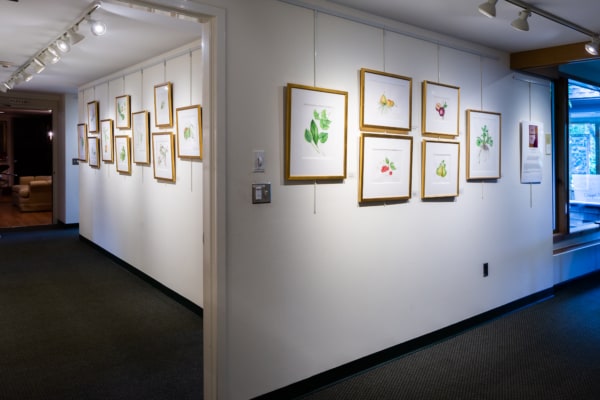
Follow out the Parlor door through the Mary Jo Rines Art Gallery which has hosted local artists’ shows throughout the years.
Learn more about the Rines Art Gallery here.
Station #8 — Solar Panels
.
These panels were installed on the church school wing in 2021, and were made possible due to a generous gift of the Francis (Tare) Newbury family. This is a major step to create a more sustainable space at First Parish Weston. This effort was led by our current minister, Rev. Jeff Barz-Snell, who was called in 2018 and continues to encourage our church community in these efforts. Reverend Barz-Snell has guided our church through the current pandemic and adopted hybrid streaming to reach parishioners & attendees for Sunday services.
Other Recent Updates
.
The new parsonage at 335 Boston Post Road was purchased in 2012 and directly abuts the church property. The space between the properties includes a fire pit and has been used by our Youth Group for outdoor programming, especially during the recent pandemic. There are now public walking trails behind First Parish Church which access the Sears Forest and rail trail.
Click here for a printable PDF containing all the information on this page – the map/floor plan and the information displayed at each tour station.

